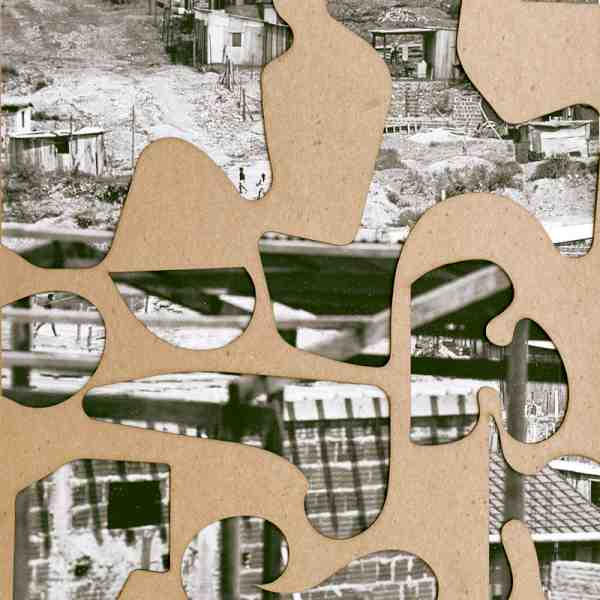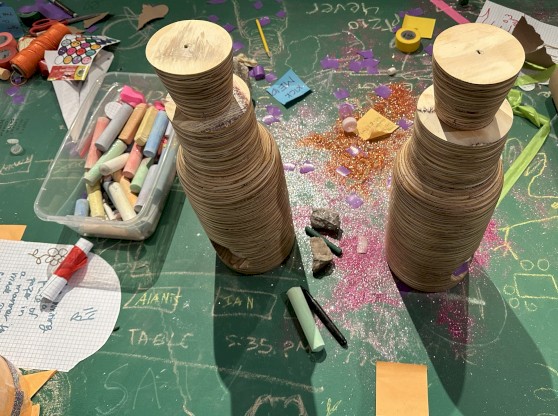Umberto Di Marino is pleased to announce Sergio Vega's exhibition titled Shamanic Modernism: Parrots, Bossa Nova, and Architecture, open September 30 to November 18, 2016. The exploration of contemporary Latin American culture, focusing specifically on the post-colonial debate, has been one of the key themes of the gallery’s program for several years. The gallery’s 2016-17 season offers a careful collective form of reflection, starting with one of the fundamental critiques of new forms of cultural colonialism.
On a trip to Mato Grosso (Brazil) that took place in 1999, Sergio Vega came across an avenue in the city of Cuiaba and wrote,
"Tall buildings were distributed alongside as if they were in a carnival parade, but instead of dancing to the deep sound of African drums they seemed to be swinging to the smooth sound of Boss anova; their monumental presence ostentatiously announcing the triumph of modernity over the jungle.
The organic facades of those buildings had pure colors and featured curved balconies. This tropical architecture established a dialogue with nature not to camouflage itself, but to contend with it. In some cases, it acquired an emblematic presence that not only competes with mango trees, coconut palms, and parrots, but also imitates them. Even if this extravagant degree of belief in the symbolic function of form deviates from the marriage of form and function, it must have made no use of avant-gardist rupture to establish itself, since its grace relies in the deviation of high modernism towards the regional."
This chance encounter signified a kind of "profane illumination" for the artist that led to the interpretation of modernist architecture in relation to shamanism, and marked the beginning of a series of investigations that took place over the course of several years.
"Thus modernist architecture went someplace else, and by forgetting Cartesian logic entered a sinuous terrain that left it under the shelter of shamanism. It is hard to tell how this detour started, if whether as a formalist exercise or as the result of heat stroke. In any case, it drove architecture into a performative space, to cross-dress as animal or plant.
When the shaman impersonates animals, speaks their tongues and emulates their movements, his actions are not just a manifestation of hysteria, but the careful construction of a sign, one that indicates to the tribe that he has entered the ‘edenic stage.’ He now embodies the spirits of the animals and the plants and much more, because in that process of transformation he has gone up a ladder or a tree with a request from the tribe and is coming down with a message from the creator. However modern, a building cross-dressed as something else and presented as a message from above is indeed an ancient idea."
Following these ideas, the artist researched key elements of Brazil's modernist architecture, urban design, and its aesthetic and conceptual relationship to bossa nova music. The works presented in the exhibition explore the paradisiac dimension of Brazilian modernism associated with shamanistic practices and interpretations of nature. In addition, the exhibition approaches the dynamics between a modernist program dictated from above (capital) and a marginal approach arising from the edges of society (poverty). In parallel tasks, while high Modernism constructs, the periphery deconstructs, developing organically, finding the empty spaces, slots and gaps that play such an important role in the deconstructionist theories of Jacques Derrida. The precarious dwellings are often built with urban waste: discarded building materials, billboards, abandoned furniture, cardboard, logs, etc.
The series "Social Landscape" is made of photographs of shantytowns with overlapping geometric abstract compositions. A new series of humorous collages titled "Interventions On a Book" takes the pages of the book Brazil's Modern Architecture (Phaidon, 2007), a milestone in the study of the topic, as readymade and juxtaposes objects and photos, painting, and drawing over the text and images of the book producing uncanny associations. The installation "Modernismo Chamánico (Cathedral-Pineapple-Bossanova)" consists of black and white photographs combined with covers of bossa nova records and a scale model of the Brasilia's cathedral by architect Oscar Niemeyer rotating on top of a turntable. The gallery thus becomes a single installation where images, sounds, photography, architecture, and nature are organically integrated into a modernist tropical environment.
# # #
Media Contact:
Galleria Umberto Di Marino
Via Alabardieri,1 - 80121 Napoli, Italia
Tel. +39 081 0609318
Fax +39 081 2142623
info@galleriaumbertodimarino.com
www.galleriaumbertodimarino.com





